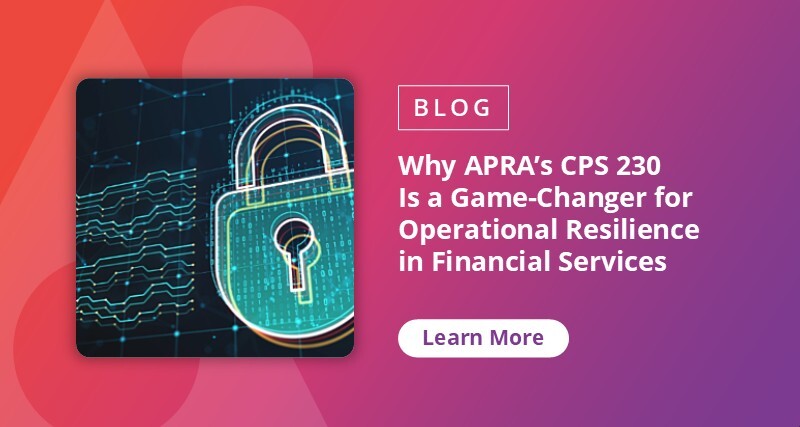The Australian financial services landscape is at a critical juncture to leverage opportunities in today’s technological evolution. Recently, AvePoint hosted an executive roundtable in Sydney to bring together different leaders from financial organisations. At this gathering, the conversation wasn't about if technology would transform the industry but "how" financial organisations would navigate the profound challenges and opportunities that arise from it. The energy in the room was palpable as we explored the strategic imperatives that go beyond mere compliance and into true thought leadership.
In this blog, we delve into the three major themes that emerged from our discussion and their direct intersection with the core principles of the Australian Prudential Authority (APRA), particularly APRA's CPS 230 (Operational Risk Management) and CPG 235 (the Prudential Practice Guide for Managing Data Risk). The connection is anything but coincidence; it's a reflection of the evolving relationship between innovation, risk, and governance in finance.
AI and Risk: The Strategic Balancing Act
The first standout theme was the delicate balance between driving productivity with AI and managing the accompanying risks. This is the central tension for every financial institution today. While AI offers the promise of unprecedented efficiency – from personalised customer service to automated fraud detection – it also introduces new vulnerabilities. Data biases, model opacity, and the sheer volume of sensitive information processed by these systems create a significant regulatory burden.
This topic aligns perfectly with the spirit of CPG 235. The Prudential Practice Guide goes beyond data security — it provides a comprehensive framework for managing data risks across the entire information lifecycle, from creation and storage to usage and disposal. The rise of AI makes this more urgent than ever. Leaders must ask themselves:
- Are our AI models trained on secure, unbiased data?
- Can we explain or validate AI-driven decisions?
Do our controls meet the transparency and fairness expectations of regulators?
Despite these challenges, the answer isn't to avoid AI but to embed risk management practices into the very foundation of AI as leveraged by financial organisations in Australia.
Governance as a Catalyst, Not a Constraint
Our second key takeaway was that the recognition that governance frameworks and guardrails aren’t simply extraneous requirements in the road to innovation; instead, they represent a key enabler of innovation and resilience. In an age of rapid technological change, a "wild west" approach to data and technology is a recipe for disaster. By establishing clear policies and accountability, financial institutions can create a controlled, secure environment where end-users are empowered to experiment and drive productivity without compromising the organisation.
This resonates deeply with CPS 230, which emphasises the need for a robust operational risk management framework. The standard outlines the importance of clearly defined roles and responsibilities for data owners and custodians, a concept that extends far beyond IT.
Boards and senior executives are now directly accountable for operational risk. This shift elevates governance from a back-office function to a strategic priority. Institutions must foster a culture where every employee – from the front line to the C-suite – understands their role in safeguarding data integrity and operational continuity.
This is a call to action: governance must be embedded into the DNA of innovation. Only then can financial institutions create environments where experimentation thrives without compromising security or trust.
Data-Driven Agility: The Foundation of Strategic Resilience
One of the most powerful insights from our roundtable was the recognition that data-driven agility is no longer a luxury — it’s a strategic imperative. In today’s dynamic financial landscape, where market conditions shift rapidly and customer expectations evolve constantly, the ability to access and act on timely, accurate data is foundational to resilience and agility.
This aligns directly with CPS 230, which requires institutions to maintain operational continuity and respond swiftly to disruptions. Data-driven agility is the enabler of this responsiveness, whether it's identifying a cyberthreat, managing a third-party outage, or recalibrating risk exposure in real time.
CPG 235 complements this by providing practical guidance on managing data risk across its lifecycle. It emphasises the importance of data quality, governance, and issue management, ensuring that the data used for decision-making is not only available but also purpose-fit.
Key strategic imperatives of CPG 235:
- Timeliness and accuracy. Real-time data enables faster, more informed decisions across risk management, compliance requirements, and customer experience.
- Operational resilience. CPG 235 supports CPS 230’s requirement for rapid incident response and continuity of critical operations.
- Data governance. CPG 235 reinforces the need for robust controls to ensure data integrity and traceability.
- Strategic agility. Institutions can pivot quickly in response to market shifts, regulatory changes, or emerging risks.
- Trust and transparency. Reliable data builds confidence with regulators, customers, and internal stakeholders.
In this context, data is no longer just an operational asset but also a strategic capability. Institutions that invest in real-time data infrastructure and governance will be better positioned to lead, adapt, and thrive in an increasingly complex financial ecosystem.

Beyond the Checklist: A Shift in Mandate for Financial Services
What really stood out during the discussion was how regulation has evolved — it’s no longer just about ticking boxes on a compliance checklist; it's about actively demonstrating that you are reducing risk. Regulators like APRA have shifted their focus from a prescriptive, rules-based approach to a principles- and risk-based framework. This means they want to see evidence that a policy is not only in place but also effective in mitigating a specific risk.
This is a fundamental shift in mindset. A regulator focused on risk wants to know:
- What are your biggest risks? You must proactively identify your key vulnerabilities, not just the ones listed in a standard.
- How are you measuring them? You need clear, quantitative metrics to show that a risk is being managed and that your controls are working.
- What have you done to reduce them? The focus is on action and outcome. Simply having a plan is not enough; you must show how you've used it to reduce potential harm.
This approach puts the onus on the organisation to truly understand its own risk landscape and to be able to validate its efforts.
The importance of validation is key to this new regulatory model. It's the process of proving that your controls are working as intended. For instance, if you state you have a control to prevent unauthorised access to sensitive data, a regulator will want to see:
- Testing and Results: Are you regularly testing this control? What were the results? If it failed, what did you do about it?
- Data and Metrics: Do you have data that shows a reduction in security incidents since the control was implemented?
Continuous Improvement: Do you have a process for reviewing your controls and adapting them as new risks emerge?
In this environment, "good enough" is no longer an option. Compliance is a byproduct of effective risk management, not a goal in itself. Organisations that succeed will be those that view regulation not as a burden, but as a framework for building a more resilient, trustworthy, and agile business.
The Road Ahead for Financial Services in Australia
Our roundtable highlighted a key shift: The starting point for resilience and innovation is showing that you're actively reducing risk. Governance, risk management, and data integrity are no longer back-office functions — they’re strategic foundations.
Frameworks like CPS 230 are pivotal prudential standards because they help financial organisations in Australia demonstrate that their controls work. When financial organisations embed these principles into their core, they unlock the ability to innovate safely, respond to disruption, and build lasting trust.
The real advantage lies not in the technology itself but in the responsible systems that support it. Embedding governance into the DNA of innovation through a unified, purpose-built platform enables experimentation without compromising security or resilience.

